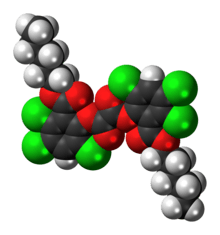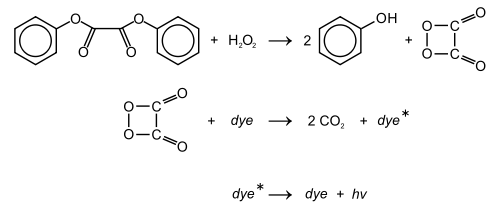Bis-(2,4,5-trichloro-6-(pentyloxycarbonyl)phenyl)oxalate
Bis-[2,4,5-trichloro-6-(pentyloxycarbonyl)phenyl]oxalate (also known as bis(2,4,5-trichloro-6-carbopentoxyphenyl) oxalate or CPPO) is a solid ester whose oxidation products are responsible for the chemiluminescence in a glowstick. It can be synthesized by reacting 2-carbopentoxy-3,5,6-trichlorophenol with oxalyl chloride. (Note: This article originally was called Bis(2,4,5-trichlorophenyl-6-carbopentoxyphenyl)oxalate, but the subsequently added picture and formula have only two phenyl groups. Since no references are given, it is unclear what compound is actually used in glowsticks.)
oxalate.png) | |
 | |
| Names | |
|---|---|
| Other names
CPPO | |
| Identifiers | |
3D model (JSmol) |
|
| ChemSpider | |
| ECHA InfoCard | 100.045.618 |
PubChem CID |
|
CompTox Dashboard (EPA) |
|
| |
| |
| Properties | |
| C26H24Cl6O8 | |
| Molar mass | 677.17 g·mol−1 |
| Melting point | 188 to 192 °C (370 to 378 °F; 461 to 465 K) |
Except where otherwise noted, data are given for materials in their standard state (at 25 °C [77 °F], 100 kPa). | |
| Infobox references | |
When mixed with hydrogen peroxide in an organic solvent (diethyl phthalate, ethyl acetate, etc...) in the presence of a fluorescent dye CPPO causes the emission of light, as per the following scheme involving 1,2-dioxetanedione (note that many side-groups of the aromatic rings are not shown.):
The reaction rate is pH dependent, and slightly alkaline conditions achieved by adding a weak base, e.g. sodium salicylate, will produce brighter light. Developed by American Cyanamid in the 1960s, the formulation containing CPPO, a fluorescer, and a glass capsule containing hydrogen peroxide and a base catalyst, all in dialkyl phthalate solvents, was marketed as Cyalume.
The following colors can be produced by using different dyes:
| Color | Compound |
|---|---|
| Blue | 9,10-Diphenylanthracene |
| Green | 9,10-Bis(phenylethynyl)anthracene |
| Yellow-green | Tetracene |
| Yellow | 1-Chloro-9,10-bis(phenylethynyl)anthracene |
| Orange | 5,12-Bis(phenylethynyl)naphthacene, Rubrene, Rhodamine 6G |
| Red | 2,4-Di-tert-butylphenyl 1,4,5,8-tetracarboxynaphthalene diamide, Rhodamine 101, Rhodamine B |
